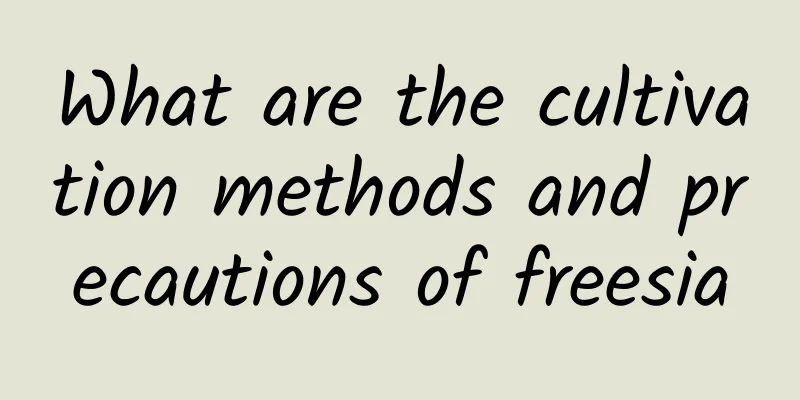What are the cultivation methods and precautions of freesia

Freesia growth habitsFreesia likes a cool, humid, sunny environment, and is not cold-resistant. The most suitable temperature for its growth is 15~20℃. The lowest temperature in winter is 3~5℃, and freesia is a short-day plant. Short light can promote flower bud differentiation. After flower bud differentiation, appropriately increasing the sunlight can promote early flowering. Freesia cultivation methodSoil selection: The cultivation soil should be loose, acidic soil containing organic matter and with good drainage. It can be mixed with leaf mold, garden soil, river sand, etc. in a certain proportion. Temperature management: Only an environment between 15°~20° can ensure its normal growth; in order to promote flower bud differentiation, the temperature can be controlled between 12-15°C. After the flower buds differentiate, the temperature should be controlled between 18-20°C. Watering method: Watering should follow the principle of watering when the soil is dry and moistening when the plant is wet. When the plant is just transplanted into the pot, it does not require too much water and watering once a week is enough. After the plant has sprouted, you need to increase the amount of watering to keep the soil moist. After the flowering period is over, gradually reduce the water supply. Fertilization method: Freesia needs more fertilizer, and you can choose phosphorus and potassium fertilizers, and fertilize once every half a month; after budding, you need to apply decomposed organic fertilizer to promote flowering; and during the flowering period, you need to apply a solution containing potassium dihydrogen phosphate, which can make the leaves grow more shiny. Be careful not to pour the fertilizer liquid on the leaves. Precautions for freesia cultivationFreesia is easily harmed by mosaic disease and bulb rot. When planting, the soil and bulbs should be thoroughly disinfected, and the potting soil should be completely replaced every year. At the same time, attention should be paid to the prevention and control of aphids. If aphids are found, they can be sprayed with 1500 times diluted 40% omethoate or 90% dichlorvos solution for prevention and control. |
<<: Can mint be grown hydroponically?
>>: What month is suitable for planting peach seedlings? When is the best time to plant them?
Recommend
How to remedy rose root rot
1. Control water and fertilizer If you find signs...
How does outdoor celery in the north survive the winter?
The best time to plant celery in the north is spr...
When is the best time to harvest soybeans?
Soybean harvest time The growth cycle of soybeans...
How to grow orchids
1. Soil When breeding, it is most suitable to use...
Cultivation method of Southwest Chlorophytum
1. Soil It does not have high requirements for so...
How to fertilize Kalanchoe? Do these three things to absorb nutrients well!
1. Fertilizer selection: The Kalanchoe can be pla...
What to do if the roots of the green radish are rotten
1. Cut off rotten roots Carefully remove the poth...
How to quickly root Chlorophytum comosum
1. Soil requirements If you want the Chlorophytum...
Cutting method of lily bamboo
A complete guide to propagating lily bamboo by cu...
Litchi seedling planting technology
Lychee trees are a famous Lingnan fruit with soft...
Cultivation methods and precautions of Tortoiseshell Peony
How to cultivate the tortoiseshell peony temperat...
What to do if you overwater your succulents (Remedies for accidentally overwatering succulents)
Youhuayou asked: If I accidentally watered the su...
What is the flower language of green gentian (flower language of different colors)
1. Flower language of green gentian The flower la...
How to care for iron trees in winter in the north
Is the iron tree afraid of freezing in the north?...
What are the varieties of summer vegetables?
In the summer, the weather is hot and the sunshin...









